To begin the treatment of onychomycosis in time, you must know how the fungus of the nails looks.Fungi related to the types of dermatophytes, candidates and yeast can cause the disease.The timely and correct determination of the pathogen will allow you to quickly and effectively cure the fungus in the legs.
What is nail fungus?
Fungal nail disease has a scientific name: onychomycosis, which of the ancient Greek means "chronic infection."This disease affects the nail plate in which the power broke for some reason.Fungi disputes spread rapidly, do not need special conditions for development.The disease itself does not occur due to the high survival of fungi.
Causes of nail fungus
Factors, as a result of which the fungus of the nails is manifested:
- Wet and warm atmosphere.After a long day in shoes, the legs sweat a lot.It is necessary to dry the shoes and completely abandon synthetic socks.
- Age.The largest number of cases of the disease occurs at the age of 18 to 55.Basically, men suffer.If in young people, the nail fungus occurs extremely rarely, then in old age men the incidence percentage of at least 90%.This is mainly due to the decrease in the growth of nail plates.
- MedicationsTaking medications, such as antibiotics and cytostatics, can cause the disease.
- The immune system.Having stepped on the legs without protection on any dirty surface, it can easily infect.A person with weak immunity to do this is much easier.
- Profession.The fungus of the nails can occur due to the high temperature in the work room, the joint or ionizing radiation.Mining employees, medical institutions, bathrooms and showers are more susceptible to the disease.
Three main paths were identified through which the fungus can fall under the nail plate of the leg:
- Through the nail roller.The nail roller is a leather fold that surrounds the nail plate from 3 sides.
- Through the edge of the nail.In this case, the fungus falls under the nail, and not in it.In the future, this can become keratosis, a disease during which the nail begins to separate from the nail bed.
- Through the dorsal part of the nail.This part is the most durable, so, through it, the fungus penetrates much less frequently.
Types of nail fungus
How do you see the nail fungus depends on what particular type of fungus the disease caused
Dermatophytes
This is the most common type of fungal disease.Dermatophyte nail plate is affected in 90% of cases.
There are 3 varieties of this disease, each of them has a different territory of the injury:
| Trichophyte Rubrum | Affecting nails and feet |
| Epidermophyte | The fungus manifests in the fingers of 1 and 5 |
| Tricoleum | The fungus manifests in the first and fifth fingers of the feet, can go to interdigital folds |
Molds
This type of disease is extremely rare.When infected, nail plate changes its color and turns black, yellow, brown or blue.
Yeast -like fungi
These fungi can manifest not only on the nails, but they are also the cause of the chain in girls.The disease causes the nail to be thinner.The nail plate acquires yellow.If the disease is ignored, then it is possible to separate the nail from the box.
Stages of the disease

How the nail fungus looks depends on the disease stage.
In medicine, it is customary to distinguish 3 main stages of its development:
- In the first stage, it is quite difficult to identify the presence of the fungus.All because there are no visible signs.
- The second stage.When moving to the second stage, the nails lose their brightness, the color of the plate begins to change gradually.The nail becomes more fragile at the edges.You can already see small white or groove spots, which will increase in size over time.
- The third stage is a careless way of pathology, when a person ignored the disease for a long time and did not treat it.At this time, there is a great risk of losing the nail.Start extensively and break more and more.
How do you see the nail fungus?Symptoms and signs
The fungus has serious symptoms.At the beginning of the disease, the brightness in the nail disappears gradually.The plate surface becomes small white spots and similar to waves.
Over time, the nail becomes fragile, squamous.Despite its fragility, the thickness of the nail can increase.Perhaps an unbearable feeling of itching between the fingers.Sleeping in the legs is gradually increasing.Probably the appearance of calluses and bubbles.
Another different sign of the disease is an unpleasant smell.This is due to the fact that the gap between the nail and the bed is obstructed with dirt and the fungus products.
When the disease is launched greatly, the patient can increase the temperature and pain in the legs, which prevents it from moving normally.
Regional onychomycosis
Regional onychomycosis is the initial stage of the disease.It is quite difficult to determine the disease at this stage.
How the nail fungus looks depends on the degree of development of pathology.A narrow gray lines appear gradually along the edges of the plate.The clove itself begins to overshadow.In the center of the nail, yellow spots of small sizes are produced.The plate does not change thickness, but it becomes fragile.
The nail is not completely affected.They only suffer their individual sections.Therefore, the surface of the affected nail is seen in pictures.Under the nail can consider gray matter, but the nail itself does not become thicker.
Normotorophic
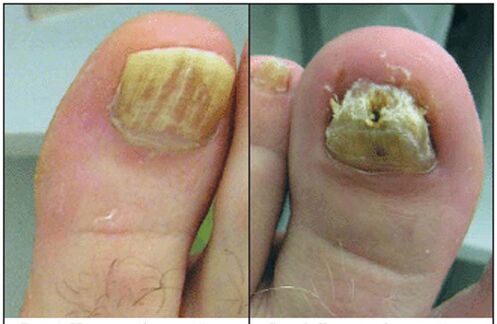
Normotrophic onicycosis occurs for the same reasons as the rest of the fungus.The microorganisms enter the skin, after which they penetrate from their surface through small damage to the nail plate.
With normotrophic onicycosis in the early days of the disease, the color of the nail does not completely change, but only in areas.On the sides and in the end, the nail becomes white, yellow or gray.The nail plate loses the brightness and fades.Over time, the color of the nail changes completely, but its thickness does not decrease.
Hypertrophic
Hypertrophic onychomycosis is considered an advanced form of a type of normotrophic disease.The causes of its occurrence are not different from the causes of other types of nail fungi.
The appearance of hypertrophic onicycosis contributes to contact with infected people, with uncomfortable shoes or hygiene interruption.The cause can also be diseases: HIV, hyperhidrosis and diabetes.
In the legs with hypertrophic onicycosis, the thickness of the nail increases significantly.Plate thickening can cause a disease such as hyperkeratosis (with a disease, skin under the clove is being keratinized).
The color of the plate changes, because it looks yellow or gray.The nails become opaque, boring.The appearance of the initiates is possible: a fungus in which the nail deforms and takes the shape of a bird's claw.
With hypertrophic onicycosis, the side parts of the nail suffer more strongly.As a result, severe pain occurs in the fingers, preventing a person from moving normally.
White superficial form
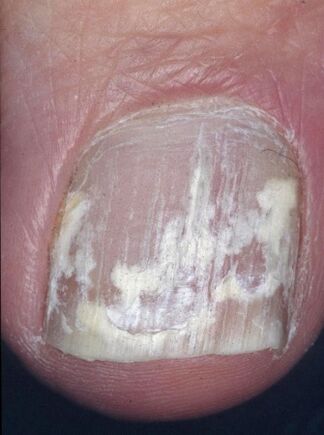
The white surface shape of onychomycosis is the rarest type of disease.With him, the thumb and little finger is damaged.
With the disease, the nail leg and the matrix do not suffer.White spots gradually appear on the nail surface.Over time, their size and area increase.The color of the spots changes from white to yellow.The nail begins to crumble.
If the disease is thrown, then the inflammation of the skin around the nail is possible.Together with him, severe and itchy redness appear.
The thickness of the plate does not change and its surface becomes rough.Often, the nails break, the brightness disappears.
People who visit the greatest risk of getting sick:
- spa;
- Saunas;
- Public books.
The combination of high humidity and heat is an ideal environment for the rapid development of a fungal disease.People who use common hygiene products and shoes have a lot of risk.
The white surface shape of onychomycosis is easy to confuse with such diseases:
- Seborrhea.
- The first stage of eccema.
- Soriasis
Therefore, the dermatologist does not stop in a visual examination of the patient.Mandatory takes biological material from it and sends it to the laboratory to determine the type of pathogen.
Onicolithic
Onicholithic onychomycosis is characterized by the separation of the nail plate from the box.The nail loses its brightness and becomes gray.In the damage area, there is a plot covered with hyperkeratosis (excessive thickening of the stratum layer of the epidermis can be 1 mm to several cm).
With a disease, both the thickening of the nail and the thinning are possible.
Onychomycosis candidiasis
This type of disease occurs due to a decrease in the protective properties of skin coating and weak immunity.Candida fungi, which live in the intestines and urinary tract, begin to multiply quickly and fill the nail plates.The disease is more common in the female half of the population.Most of the time, people who work with waiters and dishwasher suffer.
At the beginning of the disease, the fungus affects the nail roller and the skin next to it.The skin blushes and begins to become inflamed.The roller swells, the skin practically disappears.If the disease is not treated, then it can become chronic and peeled from the skin in the nail area and the nail roller will remain forever.
The rejection of treatment can cause nail deformation.Start from the roller to the center of the nail.It becomes thinner and with a slight press on the plate, the pus is possible.In the dish itself, white wave -shaped stripes are clearly visible.
There is proximal candidal onychomycosis.The difference is that the nail roller does not suffer.Determining the disease is helped by white points of small sizes under the nail.
The third form of candidal onychomycosis is distal.The fungus affects the remote part of the nail and moves towards the middle.The color of the plate changes and the nail becomes thicker.Hyperkeratosis occurs under the nail, as a result of which the nail rises.
Proximal deformation
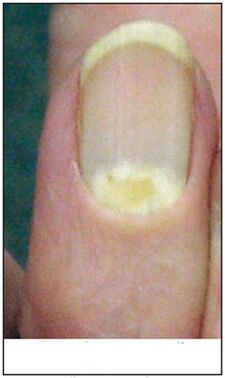
The proximal deformation onylomyosis begins to develop in case of candidate lesion of the nail plate.The main characteristic of the disease is the nail bed.With this form of disease, it deforms and becomes in the form of a wave.
Atrophic
Atrophic onychomycosis is characterized by a change in the color of the nail plate to a brownish gray.The nail is affected from the outer end and gradually moves to the skin roller.
There are also such signals:
- Loss of a natural shine of the nail.
- The plate is stunted.
- The nail bed is exposed.
- The nail is thinner and atrophy in the future.
- There are a layers of leather scales on the bed of the nail.
- The infection applies to neighboring fabrics.
With atrophic onychomycosis, only the nail outbreak remains not touched.
Treatment methods
Before starting the treatment of any form of onychomycosis, you must communicate with a dermatologist for diagnosis.Only after laboratory tests and determine the size of the affected areas, an additional patient treatment is prescribed.
As a general rule, in the treatment of onylomycosis, medications and local medicines are used to take orally.
For more effective treatment, in addition to taking medications, it is recommended to treat personal articles and general articles to exclude infection.
Perhaps treatment with the following forms:
- Physiotherapy.This procedure is prescribed to improve the blood circulation of the limbs.Physiotherapy is used in combination with UHF and ampuls-carlation in lumbosacral and cervical departments.Laser therapy and diathermia are also used.
- In the case of careless disease, when the nail is deforms and exfolia, doctors decide to remove the nail plate.This will further avoid fungus and give medications more efficiently to work on a healthy surface.
Pharmaceutical products
The main methods to combat fungal diseases include antimicotics.They cause more damage to nail fungus and, therefore, effectively treat affected areas.Antimicotics are suitable for the treatment of almost all types of diseases, with the exception of the candidate (here the treatment must be selected individually).
Dermatologists often prescribe the following antimicotics:
- Varnishes that can protect the nail from the additional development of the disease.
- Solutions that destroy the fungus of the nail rollers and the plate itself.
- Ointments or gels that relieve itching and inflammation.
When the local treatment does not give the correct effect to the maximum, the preparations are prescribed to take inside.The main difficulty of dealing with such means lies in a large amount of contraindications and precautions.The effect of drugs gradually increases.
Traditional medicine
In the treatment of a fungal disease, popular medicine can be used, but only together with other medications.
Tea fungus
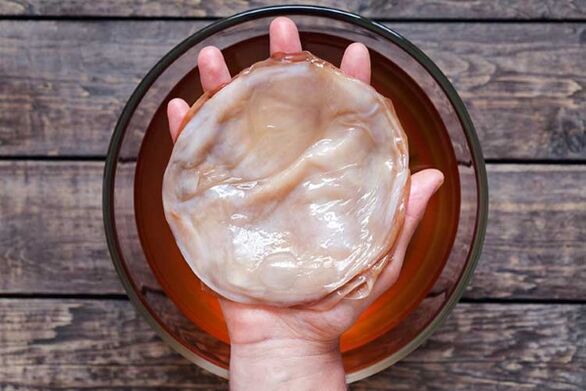
To use it, it is necessary to cook your legs.After that, a small piece of the fungus to the sick nail is applied, bent with a bandage.The compress remains all night, and in the morning it is withdrawn.Deleted dead areas must be eliminated and then treat the surface with any antiseptic.The treatment course lasts several weeks.
Air
Calamus decoction can also become an assistant in the fight against nail fungus.Take such decoction 3 times a day.During the reception, it is necessary to trim the skin and growing nails.
- To prepare the product, it is necessary 2 teaspoons.Muela the rhizomes of the plant and pour boiling water (as a rule, 100 ml is sufficient).
- Then, the rhizomas were wounded in water for no more than 1 minute.
- When the product has cooled, it is ready for use.
Due to the fact that the decoction has a bitter taste, it can be washed with water.
Acetic bathrooms
Acetic baths have a good effect only on the initial stages of the disease.In the future, they are used only with the permission of the doctor and together with other drugs.
Acetic baths soften the epidermis, improve blood circulation and also transforms the appearance of the feet.
Vinegar can be used in combination of the following components:
- Soda.It significantly affects the epidermis and improves the effect of the procedure as a whole.To prepare a solution for the procedure, it is necessary to stir 0.5 tablespoons in 3 liters of water.Vinegar with 2 tablespoons.l.soda.
- Essential oils.Such component reduces the treatment course several times.For a vinegar bath, 3 drops of oil are needed.
- Glycerol.For 3 liters of water, 9 tablespoons.l.vinegar and 3 tablespoons.l.glycerol.When preparing the solution, glycerin is added to the water for a better dilution.Glycerin in vinegar baths helps hydrate the skin of the legs.
Bathrooms can also be used as prevention.
There are a number of contraindications in which vinegar baths cannot be used:
- Oncology.
- Wounds, ulcers and scratches on the legs.
- Individual intolerance.
- Thrombophlebitis.
- Pregnancy.
- Cardiovascular system violations.
- Age up to 10 years.
Before the procedure, you must take 3 steps:
- Do a sensitivity test.A small area near the elbow is moistened with a prepared solution.After 15 minutes.There should be no allergic reactions (itching, burning, redness).
- Before the procedure, the legs must be steamed and the affected fabrics are removed.
- After the procedure, you must rinse the feet and dry well.For 2 hours, you can't load your legs.
- The duration of the procedure is 10-20 minutes.
In general, the treatment with vinegar baths lasts 2-3 weeks.
Tea tree oil
The use of tea tree oil contributes to the effective recovery of the affected nail.During the procedure, the oil must be applied under the nail in the calculation of 1 drop per 1 nail.The procedure is carried out 3 times a day.The treated nail areas must be hit with a patch, so the effect of the treatment will be greater.
Iodine processing
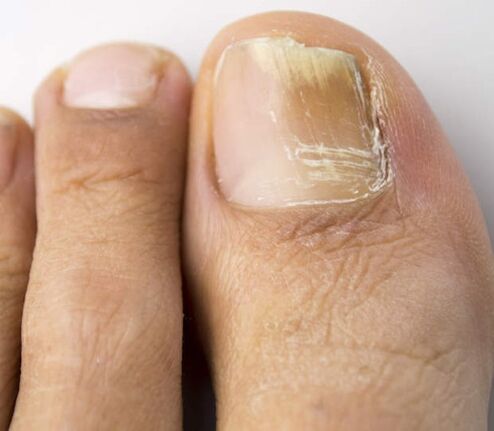
In the fight against nail fungus, iodine is widely used.It is better to use a 5% solution for the procedure.All that is needed for treatment is to apply an iodine solution 2 times a day to the affected area of the nail.
When applying iodine, an ardor sensation is possible.If the fucking feeling is weak and does not cause discomfort, everything is fine.If the pain is severe, then iodine processing must stop immediately.The course of treatment with an iodine solution is long 2-3 months.
The advanced stage of the disease can lead to more serious consequences.Whatever the form of independent treatment, the patient, in the first signs, it is necessary to consult a specialist.By the way, the nail fungus is seen, the doctor can prescribe a complete treatment.Leg onylomycosis is treated quite quickly and effectively with the correct approach.
















